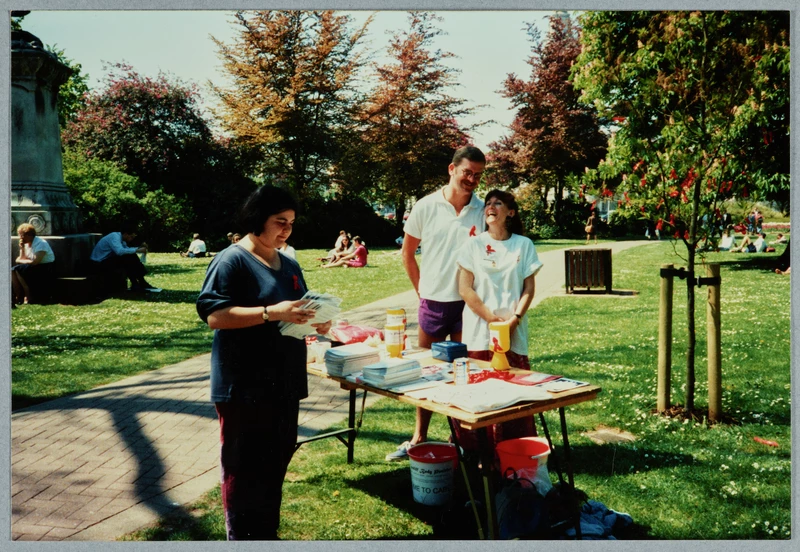Dathlu Mis Balchder! - Toredig ond Prydferth: Creu Lle, Gwella gyda'n Gilydd
, 12 Mehefin 2025
I ddathlu Mis Balchder eleni, bydd rhai o'n cynhyrchwyr amgueddfa cymru anhygoel yn cynnal gweithdai ar thema Balchder ar draws rhai o'n hamgueddfeydd ym mis Mehefin. Fel rhan o'r dathliad hwnnw, gofynnon ni iddyn nhw fyfyrio ar y themâu a'r ysbrydoliaeth y tu ôl i'w gweithdy a'r hyn y mae Balchder yn ei olygu iddyn nhw.
Y Gweithdy: Torri, Adfer, Ymadfer
Mae mis Balchder yn fwy na dathliad – mae hefyd yn gyfnod o adfer. Amser i ganfod llonyddwch. Amser i hawlio eto ein lle – yn y byd o'n cwmpas a'r byd y tu fewn i ni. Mae fy ngweithdy Toredig ond Prydferth yn byw yn y bwlch hwnnw lle mae mynegiant creadigol ac ymadfer personol yn cwrdd – lle nad yw darnau'n deilchion ond yn ddeunydd i greu rhywbeth newydd.
Dechreuodd y project hwn yn ystod fy mlwyddyn olaf, yn dilyn siwrnai bersonol yn darganfod hunaniaeth, adferiad a gwytnwch. Roedd yn fwy na phroject – daeth yn fodd o ddeall y byd a'n lle ni ynddo. Gydag amser fe dyfodd yn weithred gydweithredol ddofn: gweithdy lle gall pobl dorri gwrthrych cerameg a'i ailadeiladu gyda chlai. Mae harddwch hynod yn y broses hon – catharsis, llonyddwch a nerth tawel.
Ar ddiwedd fy nghyfnod preswyl fe ysgrifennais flog trylwyr ar gyfer Cynfas yn esbonio sut y tyfodd Toredig ond Prydferth o'r project terfynol a'n siwrnai bersonol.
Felly, pan ddes i â Toredig ond Prydferth i Amgueddfa Genedlaethol y Glannau ar gyfer Mis Balchder eleni doeddwn i ddim yn cyflwyno rhywbeth newydd. Roeddwn i'n creu lle i bobl eraill brofi'r hyn wnes i: y rhyddid o dorri ac ailadeiladu, o ymollwng, ac o greu rhywbeth newydd gyda gofal.
Yn ystod y gweithdy bydd pobl yn dewis gwrthrychau, eu torri'n ofalus, a chymryd amser yn ailadeiladu'r darnau yn feddylgar. Byth yr un peth, ond eto’n llawn ystyr. Y cyfan i gyfeiliant seiniau cerameg yn tincial yn y cefndir, nid dinistr ond dihangfa.
Darnau o Hanes: Gweithiau Wnaeth fy Nghyffwrdd
Wrth fyfyrio ar y gwaith hwn fe dreuliais i amser yn edrych drwy gasgliad LHDTC+ Amgueddfa Cymru. Roedd rhai gweithiau yn arbennig yn cyffwrdd â fi – Cwpan, Llestr Theatr a Tebot Estynedig gan Angus Suttie (1946-1993). Pan welais i Menywod Llangollen – Dillwyn a Llestri Hufen gan Paul Scott, fe stopiais i. Fe rewais i am eiliad. Roeddwn i'n teimlo fy mod i wedi canfod stori oedd ddim angen gweiddi i gael ei chlywed.
Mae'r gwaith – hambwrdd pren yn llawn darnau cerameg – fel map o’r cof. Cwpwrdd atgofion. Mae pob llafn o grochenwaith glas a gwyn yn gip ar le ac amser, serch a chwalfa. Nid casgliad cerameg yw hwn, ond tirlun o emosiwn. Rhyw archif dawel. Fel artist a churadur yn ymdrin â themâu hunaniaeth ac adfer, roeddwn i'n uniaethu'n syth gyda gwaith Paul Scott.
Adferwn, nid i guddio’r graith, ond
i'w holrhain a'i dyrchafu. Er chwalu'r
gorffennol – daliwn bob darn fel
atgof o'r gwanwyn.
Mae'r cyfeiriad at Fenywod Llangollen – Eleanor Butler a Sarah Ponsonby – yn haen dyner arall. Dwy fenyw a heriodd ddisgwyliadau'r 18eg ganrif, gan gydfyw mewn cyfeillgarwch rhamantus a throi eu cartref yn hafan i wybodusion, artistiaid a meddylwyr yr oes. Byddwn yn aml yn rhamantu eu hanes, ond yma yng ngwaith Paul Scott mae'n real. Yn gyffredin. Darnau o fywyd bob dydd y cartref a'r platiau, y cwpanau, a'r llestri hufen yn orlawn o atgofion, agosatrwydd, a safiad cwiar.
Y peth mwyaf teimladwy i fi yw nad yw'r gwaith yn ceisio 'trwsio' unrhyw beth. Nid yw'r darnau toredig wedi eu cuddio neu eu gorfodi i'w ffurf wreiddiol. Maen nhw wedi'u fframio. Eu dal. Eu hailddehongli. Ac mae urddas tawel yn hynny. Safiad tawel sy'n dweud mwy o wirionedd nag unrhyw adferiad.
I mi mae Menywod Llangollen yn adleisio bwriad Toredig ond Prydferth: nid i guddio'r creithiau ond i'w dyrchafu. Nid i geisio adfer rhywbeth i'w ffurf wreiddiol, ond gadael iddo dyfu'n rhywbeth arall – rhywbeth sy'n adrodd gwirionedd ei stori.
Yn y weithred hon – o greu nid o guddio – mae grym y gwaith.
Perthyn drwy Greu
Drwy Amgueddfa Cymru rydw i wedi cal cyfle i ddod i nabod Bloedd – rhaglen dan arweiniad pobl ifanc i ddyrchafu lleisiau LHDTC+ ar draws Cymru. Os ydych chi'n berson ifanc, mae lle yn Bloedd i chi. I greu, i siarad, i berthyn.
Dros Fis Balchder eleni rydw i'n dathlu mwy na hunaniaeth. Dwi'n dathlu'r nerth tawel mae'n ei gymryd i adfer, a nerth cydweithio.
Mae cymaint mwy i'r gweithdai hyn na chreadigrwydd. Maen nhw'n llefydd i fyfyrio, bodoli a gwella. Hyd yn oed yn deilchion, rydyn ni’n un darn.
Cynhyrchwyr Amgueddfa Cymru yw grwp pobl ifanc rhwng 16 – 25 oed sy’n byw yng Nghymru a chydweithio gyda’r Amgueddfa drwy gyfleoedd cyfranogol a chyflogedig.
Hwn yw lle i ddyfnhau gwybodaeth a sicrhau bod mannau treftadaeth a diwyllianol yn fwy cynrychioliadol o’r bobl ifanc a’u diwylliannai niferus sy’n byw yng Nghymru neu o Gymru. Rydyn ni yma i wneud treftadaeth yn berthnasol.
Rydyn yn edrych ar gelf, treftadaeth a hunaniaeth, amgylcheddaeth, gwyddorau naturiol, hanes cymdeithasol ac archaeoleg drwy ein casgliadau a chyd-cynhyrchu digwyddiadau, gweithdai, arddangosfeydd, cyfryngau digidol cyhoeddiadau, grwpiau datblygu a mwy! Mae ein Cynhyrchwyr Amgueddfa Cymru yn gweithio’n agos gydag adrannau ar draws yr Amgueddfa i'n helpu ni ddyfnhau cynrychiolaeth yn ein casgliadau a rhaglenni, i adlewyrchu pob cymuned yng Nghymru. Mae hyn yn cynnwys ehangu ein casgliadau LHDTC+, dad-drefedigaethu ein casgliadau a chasglu hanesion llafar ar hanes dosbarth gweithiol. Gall Cynhyrchwyr Amgueddfa Cymru hefyd ddod â’u syniadau neu bynciau y hoffen nhw archwilio trwy ein casgliadau!
Cofrestrwch ar gyfer ein rhestr bost i glywed am gyfleoedd ar draws yr Amgueddfa yma.
Cewch gysylltu drwy e-bostio bloedd.ac@amgueddfacymru.ac.uk. Dilynwch ni ar Instagram i gael y wybodaeth ddiweddaraf am Bloedd!







